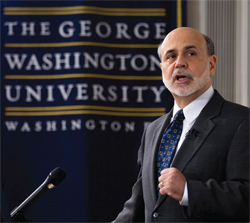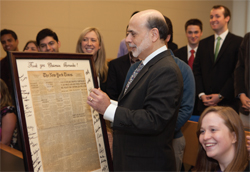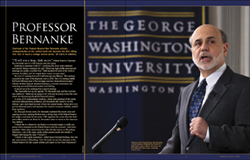Professor Bernanke
Chairman of the Federal Reserve Ben Bernanke schools undergraduates on the central bank and becomes the first sitting Fed chair to teach a college lecture series.
"I'll tell you a deep, dark secret," Federal Reserve Chairman Ben Bernanke said to a GW business class this spring.
Referring to meetings of the G-7, involving the seven most industrialized nations' finance ministers, he said, "These big, high-profile international meetings are usually a terrible bore." Staff members do most of the work in advance, he added, and "it's simply fairly routine in most cases."
But one G-7 meeting four and a half years ago was different. This meeting occurred at the onset of the financial crisis in 2008. The U.S. housing bubble had burst following years of bad mortgage practices, financial services giant Lehman Brothers had just declared bankruptcy, economic uncertainty was mounting, and world financial markets were halting.
It turned out to be anything but a typical meeting.
"We essentially tore up the agenda," Dr. Bernanke said, and the conversation shifted to: "What are we going to do? How are we going to stop this crisis which was threatening the global financial system?"
A group of 30 undergraduate students—along with members of the media, university administrators, professors, and thousands who tuned in via live webcast—got a first-hand account of how the central banker, whose job it is to prevent financial panics and maintain the country's economic stability, tackled those questions.
In a four-part lecture series, Dr. Bernanke explained the recent crisis and ongoing recovery, marking the first time a sitting chair of the Federal Reserve has taught a university lecture series. GW organized the course after the chairman's office reached out about Dr. Bernanke's desire to return to the classroom (see sidebar).
"I think this is a dream for any finance or economics major or really any person who's interested in the Federal Reserve and the economy," said senior Jonathan Cohen when interviewed live after the first lecture on Bloomberg Television—one of the many media outlets present inside and outside of Duqués Hall during the class. "I loved it."
"I think it was a great experience," added senior Michael Feinberg, who was also interviewed on Bloomberg. "He's obviously not just the chairman of the Federal Reserve but also a great scholar and expert on the Great Depression."
"A Match Thrown on Kindling"
The chairman gave a comprehensive overview of the Fed—beginning with its formation in 1913—to provide students with a historical context for understanding today's challenges.
For Dr. Bernanke, the full scope of those challenges was difficult to predict. Two weeks after he became chairman in 2006, he testified to Congress about falling home prices and warned that the housing market's decline could lead to a recession.
But the Fed "didn't anticipate that the decline in housing prices would have such a broad-based effect on the stability of the financial system," Dr. Bernanke told the class, adding that he did not think that it would have a much more severe impact on the economy than the decline in dot-com stocks in the late '90s, which caused a comparatively mild recession.
The decline in house prices and the mortgage losses amounted to "a match thrown on kindling," he said.
"But there would not have been a conflagration unless there was a lot of dry tinder around. And in this case there were vulnerabilities in the economy and the financial system that the housing bust set afire."

Chairman of the Federal Reserve Ben Bernanke, a former professor, delivered four lectures to a GW business class in March and became the first sitting Fed chair to give a university lecture series.
AP Photo/Manuel Balce Ceneta
He explained that the "kindling" for the financial fire was high private-sector debt, poor risk management by a variety of entities, and failures of consumer protection regulation and supervision.
"In other words, there were weaknesses in the financial system that transformed what might otherwise have been a modest recession into a much more severe crisis," Dr. Bernanke said.
The crisis was a classic financial panic—like a bank run—except that it occurred in a broader financial market setting, explained Dr. Bernanke, who taught at Princeton and Stanford universities before being appointed Fed chairman.
"There was a whole series of runs, which generated huge pressures on key financial firms as they lost their funding and [were] forced to sell their assets quickly, and many important financial markets were badly disrupted," Dr. Bernanke said.
The mortgage losses themselves weren't the problem, he said.
"If you took all of the subprime mortgages in the United States and put them all together and assumed they were all worthless, the total losses to the financial system would be about the size of one bad day in the stock market. They just weren't that big," Dr. Bernanke said. The real problem was that they were distributed throughout different securities and different places, and "nobody really knew where they were and who was going to bear the losses."
Revisiting the lessons from the Great Depression, a topic in which Dr. Bernanke is a noted expert, he explained that the Fed responded to the 2008 crisis by using the two primary tools of central banks: serving as the "lender of last resort" and adjusting monetary policy.
He told students that during the Great Depression the Fed did not take enough actions to stabilize the banking system or prevent inflation. The Fed must lend freely to halt runs and restore market functioning in a financial panic, he said, and accommodative monetary policy is necessary to help avoid a deep depression.
"Heeding those lessons, the Federal Reserve and the federal government did take vigorous actions to stop the financial panic," Dr. Bernanke said.
Dr. Bernanke's explanation of the situation was not a hero's tale. Though he believes in the Fed's need to intervene as necessary, he explained that the actions were not pleasant, and his tone suggested an acknowledgment that some of the measures continue to be debated in economic circles.
Too Big to Fail
Through his lectures, Dr. Bernanke recounted the "too big to fail" phenomenon, in which large firms are involved in so many areas of the financial system that their failure would threaten the economy and spur government assistance.
After the Lehman Brothers news, the financial crisis began to spread like wildfire. The Fed later intervened to help rescue financial firms Bear Stearns and AIG, but Dr. Bernanke said helping Lehman Brothers was not an option.
"We were helpless because it was essentially an insolvent firm," Dr. Bernanke said about Lehman Brothers. "It didn't have enough collateral to borrow from the Fed. We can't put capital into a firm that's insolvent. This was before the TARP [Troubled Asset Relief Program] or anything else that provided capital that the Treasury could use…so we really just had no legal way to do it. I think if we could have avoided that, we would have done so."
They made judgments on a case-by-case basis, he said, "and we were trying to be as conservative as possible."
In discussing the controversial decision to rescue insurance giant AIG in late 2008, Dr. Bernanke sighed, and his voice lowered. Given that AIG was involved in, among many activities, selling credit insurance to the owners of mortgage-backed securities, "it became evident that AIG was in big trouble," he said.
"The failure of AIG, in our estimation, would have been basically the end," he said. "It was so interconnected with both the U.S. and the European financial systems—global banks—we were quite concerned that if AIG went bankrupt that we would not be able to control the crisis any further."

Students and professors present Dr. Bernanke with a gift after his last lecture to the class.
William Atkins
AIG had taken a lot of losses but still had many good assets to serve as collateral for the $85 billion loan it had received from the government. (Which, given all of the media attention garnered by the AIG deal, Dr. Bernanke was quick to note is being paid back—though the Treasury still owns a majority share of its stock.)
"What we had to do with Bear Stearns and AIG is obviously not a recipe for future crisis management," Dr. Bernanke noted. "First of all, it was a very difficult and in many ways distasteful intervention that we had to do on the grounds that we had to do that to prevent the system from collapsing…. But clearly there's something fundamentally wrong with a system in which some companies are quote 'too big to fail.'
"We want to be sure that if a large, systematically critical firm like AIG comes under this kind of pressure in the future, there will be a safe way to let it fail." So if it fails, he said, the consequences are shouldered by the company management, shareholders, and creditors.
Reflections
In the end, the Fed made 21,000 loans by December 2010. With the Fed's actions, the chairman said the nation "avoided much worse outcomes in terms of both the financial crisis and the depth and severity of the resulting recession."
With unemployment data and other markers of a continuing recession still making headlines daily, the chairman said the crisis has required a lot of rethinking about how the Fed manages policy and its responsibilities for the financial system.
"Financial crises will always be with us; that is probably unavoidable," Dr. Bernanke said. "We've had financial
crises for 600 years in the Western world….But given what the potential for damage is now, as we've seen, it's really important for central banks and other regulators to do all we can first to try to anticipate or prevent a crisis, but if a crisis happens, to mitigate it and to make sure the system is strong enough that it will be able to make it through the crisis intact."
As the chairman continues his work, students in the class—and many more who tuned in outside of GW—are benefiting from his teachings on the economy.
"I think it provides an extraordinary opportunity for the students who are here in the classroom," President Steven Knapp said while introducing the chairman at the first lecture, "but also for those watching online, that they have an opportunity to gain insight into the nation's central banking system and a wide range of issues that affect this country and the world."
To view materials from Dr. Bernanke's lectures, as well as videos of the classes, visit business.gwu.edu/fed/index.cfm.
In Class With the Fed Chair
When Tim Fort, chair of the Department of Strategic Management and Public Policy, heard that Ben Bernanke was interested in lecturing, he decided to build a course around the chairman's lessons.
Students from across the university were selected for the course based on their résumés and essays they wrote demonstrating their interest in the Fed. The class included Dr. Bernanke's four lectures, followed by presentations from 14 other professors who covered a range of topics, including the constitutionality of the Fed, its international relationships, and its political independence.
"We really looked at the sociopolitical context of where the Fed sits in global life," says Dr. Fort, who added that the class has resulted in a "nice bond with GW and the Fed." Dr. Bernanke has since hosted the students on a trip to the Fed and has asked for intern recommendations.
But first, the chairman gave students a thorough introduction to the history of the central bank and a personal examination of the economic landscape.
A glimpse of what Dr. Bernanke shared with the class:
• Whether the Fed Should Have Responded to the Housing Bubble by Adjusting Interest Rates "The problem with tying interest rate policy to perceived bubbles and asset prices is it's like using a sledgehammer to kill a mosquito. The problem is [that] housing is only one part of the economy, and interest rates are dedicated to achieving overall economic stability."
• Great Depression vs. Great Recession "In the Depression of the '30s, there were thousands of bank failures, but almost all of the banks that failed in the '30s, at least in the United States, were small banks….The difference in 2008 was that there were many small banks that failed in the United States, but there were also intense pressures on quite a few of the largest financial institutions in the United States."
• Public Perception of the Fed "As you know, the Fed has done more outreach—press conferences and other kinds of tools—to try to explain what we did and what we're doing….It's inherently difficult because the Fed is a complicated institution….All we can do is do our best and hope that our educators and our media and so on will begin to carry this story and help people understand better. It is a difficult challenge, and it does reflect a tension that has been in American feelings about central banks ever since the beginning."
• The Pace of Recovery "If you look at recessions in the post-war period in the United States, you see very frequently that recoveries only take a couple of years. In fact very sharp recessions are typically followed by a faster recovery. That's been the pattern in the postwar period. What may be different about this episode—and again, once more, this is a subject of debate—is that unlike the other recessions in the postwar period, this one was related to and triggered by a global financial crisis. So it may be that it's going to take longer—it is already taking longer—for the economy to recover."
• The Future "I think there's a reasonable chance, looking at the long-run history, that the U.S. economy will return to healthy growth, somewhere in the 3 percent range."

